 W
WRocket artillery is artillery that uses rocket explosives as the projectile. The use of rocket artillery dates back to medieval China where devices such as fire arrows were used. Fire arrows were also used in multiple launch systems and transported via carts. By the late nineteenth century, due to improvements in the power and range of conventional artillery, the use of early military rockets declined; they were finally used on a small scale by both sides during the American Civil War. Modern rocket artillery was first employed during World War II, in the form of the German Nebelwerfer family of rocket ordnance designs, Soviet Katyusha-series and numerous other systems employed on a smaller scale by the Western allies and Japan. In modern use, the rockets are often guided by an internal guiding system or GPS in order to maintain accuracy.
 W
WThe Mars was a Soviet solid-fuel tactical missile system with a range of 7 to 18 km.
 W
WThe 2K6 Luna is a Soviet short-range artillery rocket complex. Luna rockets are solid-fuel, unguided and spin-stabilized. "2K6" is its GRAU designation. Its NATO reporting names are FROG-3 and FROG-5. From 1965, the 2K6 Luna was replaced by the far more successful 9K52 Luna-M, which was known in the West as the FROG-7.
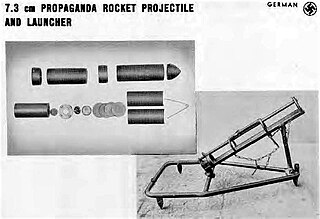 W
WThe Propagandawerfer 41 was a rocket launcher for the associated non-lethal Propagandagranate 41 rocket. The launcher and rocket were a light man-portable system fired by specially-trained propaganda troops during World War II to distribute leaflets.
 W
WThe 8 cm Raketen-Vielfachwerfer was a multiple rocket launcher produced in Nazi Germany during the Second World War.
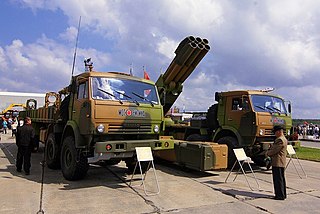 W
WThe 9A52-4 Tornado is Russia's newest universal multiple rocket launcher. It was designed as a lightweight and universal version of the BM-30 Smerch, dubbed 9A52-2. It was first unveiled in 2007 as a more strategically and tactically mobile launcher, albeit at the expense of a slight reduction in firepower. This model is aimed at replacing the previous generation of Russian multiple rocket launchers, including BM-21 Grad, BM-27 Uragan and BM-30 Smerch. Currently the sole operator is Russian Ground Forces. A version will be approved for export.
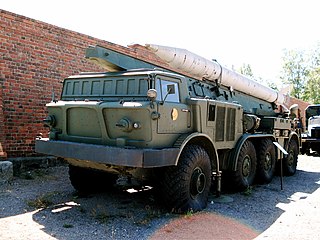 W
WThe 9K52 Luna-M is a Soviet short-range artillery rocket system which fires unguided and spin-stabilized 9M21 rockets. It was originally developed in the 1960s to provide divisional artillery support using tactical nuclear weapons but gradually modified for conventional use. The 9K52 was eventually succeeded by the OTR-21 Tochka.
 W
WThe 15 cm Nebelwerfer 41 was a German multiple rocket launcher used in the Second World War. It served with units of the Nebeltruppen, German Chemical Corps units that had the responsibility for poison gas and smoke weapons that were also used to deliver high-explosives during the war. The name Nebelwerfer is best translated as "smoke mortar".
 W
WThe 20 cm naval rocket launcher was a rocket artillery system used by the Imperial Japanese Navy in the final stages of World War II.
 W
WThe 21 cm Nebelwerfer 42 was a German multiple rocket launcher used in the Second World War. It served with units of the Nebeltruppen, the German equivalent of the American Chemical Corps. Just as the Chemical Corps had responsibility for poison gas and smoke weapons that were used instead to deliver high-explosives during the war so did the Nebeltruppen. The name "Nebelwerfer" is best translated as "Smoke Mortar". It saw service from 1942–45 in all theaters except Norway. It was adapted for aerial combat by the Luftwaffe in 1943.
 W
WThe 30 cm Nebelwerfer 42 was a German multiple rocket launcher used in the Second World War. It served with units of the Nebeltruppen, the German equivalent of the U.S. Army's Chemical Corps. Just as the Chemical Corps had responsibility for poison gas and smoke weapons that were used instead to deliver high-explosives during the war so did the Nebeltruppen. The name "Nebelwerfer" is best translated as "Smoke Mortar". It saw service from 1943–1945 in all theaters except Norway and North Africa.
 W
WThe 30 cm Raketenwerfer 56 was a German multiple rocket launcher used in the Second World War. It served with units of the Nebeltruppen, the German equivalent of the U.S. Army's Chemical Corps. Just as the Chemical Corps had responsibility for poison gas and smoke weapons that were used instead to deliver high-explosives during the war so did the Nebeltruppen. The name "Nebelwerfer" is best translated as "Smoke Mortar". 694 saw service from 1944–45 in all theaters except Norway.
 W
WThe 45 cm naval rocket was a rocket artillery system used by garrison troops of the Imperial Japanese Navy during the late stages of World War II in defense of island bases in the Pacific.
 W
WThe al-Quds 101 Rocket is a homemade rocket made and used by the Palestinian Islamic Jihad for use in attacks against Israel. The al-Quds 101 is most likely similar to the Qassam rocket series used by Hamas.
 W
WThe Bateleur is a South African self-propelled multiple rocket launcher. It is a 127mm system with a wheeled launcher vehicle, disposable pods, and fire control equipment developed by Denel Land Systems. Based on a mine protected Kwêvoël 100 10 ton 6x6 carrier. Its mission is to engage in counter-battery strikes against hostile artillery and air defences as far as 36 km (22 mi) away. Other potential warheads include cluster and an anti-tank mine dispenser. The weapon can fire up to 40 127mm pre-fragmented high explosive warheads to ranges of 7.5km to 36km at sea level singly or using ripple fire, firing up to 1 rocket per second. Reload can take less than 10 minutes and in/out-of-action time is one and two minutes respectively. The system is supported by a Kwêvoël 100 ammunition truck carrying 96 rockets and crew who help with the reloading.
 W
WThe Congreve rocket was a type of rocket artillery designed by British inventor Sir William Congreve in 1804. There has been much discussion of whether or not the Congreve war rocket was a British or Indian invention. The design was based upon rockets deployed by the Kingdom of Mysore against the East India Company during the Second, Third, and Fourth Anglo-Mysore Wars. Lieutenant general Thomas Desaguliers, colonel commandant of the Royal Artillery at Woolwich, was impressed by reports of their effectiveness, and undertook several unsuccessful experiments to produce his own rocket weapons. Several captured Mysorean rockets were sent to England following the annexation of the Mysorean kingdom into British India following the death of Tipu Sultan in the siege of Seringapatam.
 W
WThe EXTRA EXTended Range Artillery is an artillery rocket system developed and manufactured by Israel Military Industries IMI and used by Israel Defense Forces, Azerbaijan and Vietnam since 2013. It has a maximum range of 150km with a 120kg unitary warhead and accuracy of 10m CEP.
 W
WThe Fajr-3 is an Iranian heavy 240 mm intermediate-range multiple-launch artillery rocket (MLRS). The Fajr-3 is a license-built copy, with slight modifications, of a North Korean MLRS called the M-1985. The Fajr-3 was introduced in the 1990s and has since been exported to Hamas and Hezbollah.
 W
WThe Fajr-5 is an Iranian 333 mm long-range multiple launch rocket system (MLRS). The Fajr-5 was developed during the 1990s and has since been exported to various armed actors in the Middle East.
 W
WThe Falaq-1 missile is an Iranian made rocket system. It was developed in the 1990s by Shahid Bagheri Industrial Group, which is part of the Aerospace Industries Organization.
 W
WThe Falaq-2 missile is second generation of Falaq unguided artillery rocket systems, this system was also developed in the 1990s by the Shahid Bagheri Industries, which is part of the Aerospace Industries Organization.
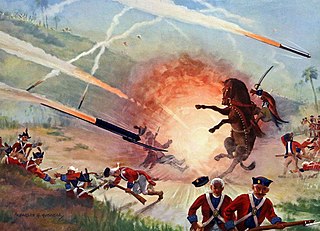 W
WFathul Mujahidin is a military manual that was written by Zainul Abedin Shustari at the instruction of Tipu Sultan, the ruler of the Kingdom of Mysore in South India considered a pioneer in the use of rocket artillery. Mysore started to equip their army with rockets in the 1750s and during the Second Anglo–Mysore War (1780–1784) Tipu and his father Haider Ali used this technology against British troops. Tipu Sultan used rockets in battle with the British Army in the 1792 Siege of Srirangapatna, a battle at the end of the Third Anglo-Mysore War.
 W
WFire arrows were one of the earliest forms of weaponized gunpowder, being used from the 9th century onward. Not to be confused with earlier incendiary arrow projectiles, the fire arrow was a gunpowder weapon which receives its name from the translated Chinese term huǒjiàn (火箭), which literally means fire arrow. In China a 'fire arrow' referred to a gunpowder projectile consisting of a bag of incendiary gunpowder attached to the shaft of an arrow. Fire arrows are the predecessors of fire lances, the first firearm.
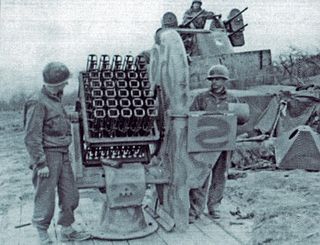 W
WThe Henschel Hs 297 Föhn or 7.3 cm Raketen Sprenggranate was a small German surface-to-air rocket of the Second World War. The associated multiple rocket launcher was known as the 7.3 cm Föhn-Gerät.
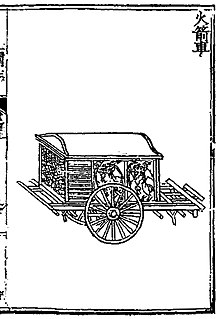 W
WHuo Che or rocket carts are several types of Chinese multiple rocket launcher developed for firing multiple fire arrows. The name Huo Che first appears in Feng Tian Jing Nan Ji, a historical text covering the Jingnan War of Ming dynasty.
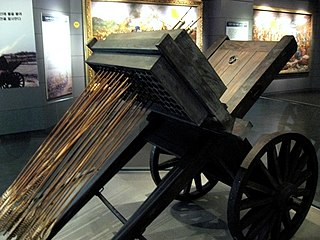 W
WThe hwacha or hwach'a was a multiple rocket launcher and an organ gun of similar design which were developed in fifteenth century Korea. The former variant fired one or two hundred rocket-powered arrows while the latter fired several dozen iron-headed arrows or bolts out of gun barrels. The term was used to refer to other war wagons or other cart-based artillery in later periods, such as that developed by Byeon Yijung in the 1590s.
 W
WThe Jobaria Defense Systems Multiple Cradle Launcher, also called Jahanam Launcher, is an Emirati made multiple rocket launcher unique to the United Arab Emirates Army. It has 240 tubes making it the world's largest rocket artillery by tube count. It is thought to function as a combined form of BM-21 Grad multiple rocket launcher. It is developed by a joint venture Al Jaber Land Systems.
 W
WThe Landing Craft Tank (Rocket) or LCT(R) was developed from the British Mk.2 and Mk.3 Landing Craft Tank (LCT) during the Second World War. It was designed to saturate beaches with up to 1,066 RP-3 "60 lb" rockets prior to the landing of troops. Used by both British and U.S. forces, the craft saw service in the Normandy landings, the Mediterranean and the Far East.
 W
WThe LAR-160 is a light artillery rocket with a 160mm calibre, a minimum range of 12 km and a maximum range of 45 km, from a multiple rocket launcher. Each standard launcher holds two 13 rocket Launch Pod Containers (LPC's) for truck or trailer mounting, 18 rocket LPC's for medium armored vehicle's and 26 rocket LPC's for mounting on a MBT chassis. A light version is also manufactured which can be carried by helicopters and towed behind vehicles such as a HMMWV.
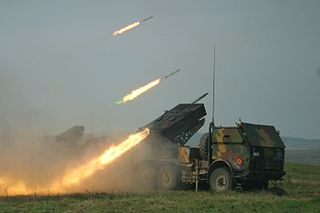 W
WThe LAROM is a Romanian native-made, highly mobile, multiple rocket launcher, attached to a DAC-25.360 6x6 truck, in service with the Romanian Land Forces, built in collaboration with Israel. Currently there are 54 systems in service, all operated by the 8th Mixed Artillery Brigade. Most likely it was influenced by the BM-21 Grad 122 mm multiple rocket launcher (MRL) system which entered service with the Soviet Army in 1963 also utilizing a six-by-six truck chassis fitted with a bank of 40 122mm launch tubes arranged in a rectangular shape that can be turned away from the unprotected cabin.
 W
WThe LRSVM Morava is a modular, multi-calibre, multi-pod self-propelled multiple rocket launcher designed and developed by the Serbian Military Technical Institute in Belgrade (VTI). The system is designed to offer subsystem modularity, enabling integration with wheeled or tracked platforms to fire unguided rockets of various calibres to engage targets at ranges between 8 km and 40 km.
 W
WThe M-87 Orkan is a Yugoslavia fully automated self-propelled multiple rocket launcher. The generic M-87 project was configured with 12 launch tubes mounted on a FAP 2832 truck. It has a range of about 50 to 120 km, with the ability to deliver warheads, anti-tank and anti-personnel mines. The production of Orkan M-87 ceased in the early 1990s due to break-up of Socialist Federal Republic of Yugoslavia.
 W
WThe M55 rocket was a chemical weapon developed by the United States in the 1950s. The United States Army produced both Sarin and VX unitary warheads for the M55.
 W
WMAR-290 is a 290 mm single-stage ground-to-ground multiple rocket launcher manufactured by Israel Military Industries introduced in 1973. The rocket was based on the Soviet-made 240mm BM-24 MLRS. The rocket's maximum range was 42 kilometers and was based on Centurion (tank) or M4 Sherman chassis.
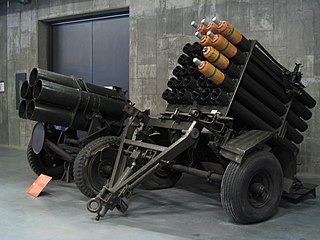 W
WMattress was the term applied to ground-based British-devised multiple rocket launchers during World War II. Compared with the German and Soviet forays into this area the western Allies deployed these weapons late in the war. Nevertheless, they did see useful service as artillery support during the crossings of the Rhine and the Scheldt rivers.
 W
WIn the military, vehicles such as trucks or tractor units can be used to transport or launch missiles, essentially a form of rocket artillery. Such a vehicle may transport one or multiple missiles. The missile vehicle may be a self-propelled unit or the missile holder/launcher may be on a trailer towed by a prime mover. They are used in the military forces of a number of countries in the world. Long missiles are commonly transported parallel to the ground on these vehicles, but elevated into an inclined or vertical position for launching. Missile vehicles include transporter erector launchers (TEL) and multiple rocket launchers (MRL) such as the Patriot missile system. Single or dual missile vehicles often transport their missiles uncovered. The missile batteries of multiple rocket launchers often hold their missiles inside tubular or rectangular canisters for each missile, from which the missiles or rockets can be launched. Many missile trucks use pneumatic (air-filled) tires, although they may be large and specialized for offroad travel. However, some missile vehicles use tractor crawler drive similar to that of a tank.
 W
WThe Naze'at 6-H and Naze'at 10-H/Mushak-120/Iran-130 are two Iranian long-range artillery rockets with ranges of about 100 km. The Naze'at 10-H is larger, more powerful, and has a longer range than the Nazeat 6-H. Like Iran's similar shaped Zelzal rockets, Naze'at rockets do not have a guidance system. Both systems are also widely known without the -H suffix, as the Naze'at 6 and Naze'at 10. The Iranians also have developed another 500 kg version called the Mushak-160 with 160 km range.
 W
WNDL-40 is a towed multiple rocket launcher developed and produced by IPTN of Indonesia. The weapon system used 70mm rockets as projectile. The rocket used is produced by IPTN under license from Belgium.
 W
WThe Nebelwerfer was a World War II German series of weapons. They were initially developed by and assigned to the Wehrmacht's "smoke troops" (Nebeltruppen). This weapon was given its name as a disinformation strategy designed to fool observers from the League of Nations, who were observing any possible infraction of the Treaty of Versailles, into thinking that it was merely a device for creating a smoke screen. They were primarily intended to deliver poison gas and smoke shells, although a high-explosive shell was developed for the Nebelwerfer from the beginning. Initially, two different mortars were fielded before they were replaced by a variety of rocket launchers ranging in size from 15 to 32 centimetres. The thin walls of the rockets had the great advantage of allowing much larger quantities of gases, fluids or high explosives to be delivered than artillery or even mortar shells of the same weight. With the exception of the Balkans Campaign, Nebelwerfer were used in every campaign of the German Army during World War II. A version of the 21 cm calibre system was adapted for air-to-air use against Allied bombers.
 W
WThe LRSVM M18 Oganj is a modular self-propelled multiple rocket launcher developed in Serbia on 6x6 chassis. It can have 2 to 8 containers with different guided and unguided missiles.
 W
WThe Iranian Oghab sometimes spelled as Akab and Okab missile is an unguided 230 mm (9 in) artillery rocket with a range of 34–45 km (20–28 mi). It is spin-stabilized in flight but has a proven circular error probable in excess of 500 m (1,500 ft), making it a highly inaccurate weapon. It carries a 70 kg (150 lb) high explosive fragmentation warhead, though it may also be able to carry chemical warheads. According to US sources, a modified version has been developed that could be carried and fired from Iranian Air Force F-14 Tomcat and F-4 Phantom II aircraft. The launcher is an elevatable triple-rail launcher assembly fitted to a Mercedes-Benz LA 911B 4×4 truck chassis.
 W
WThe Pereh is an Israeli guided missile carrier, disguised as a tank. Serving the Israel Defense Forces in the role of precision artillery since the mid 1980s, the existence and nature of the vehicle was kept classified until declassification in June 2015.
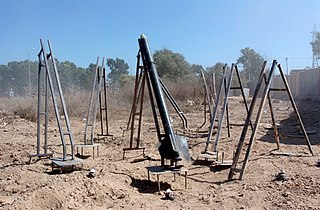 W
WThe Qassam rocket is a simple, steel artillery rocket developed and deployed by the Izz ad-Din al-Qassam Brigades, the military arm of Hamas. These rockets cannot be fired to target specific military objectives in or near civilian areas, and are "indiscriminate when used against targets in population centers".
 W
WThe R-11 Zemlya, GRAU index 8A61 was a Soviet tactical ballistic missile. It is also known by its NATO reporting name SS-1b Scud-A. It was the first of several similar Soviet missiles to be given the reporting name Scud. Variant R-11M was accepted into service, with GRAU index 9K51.
 W
WR-Han 122 is a family of rocket artillery developed by PT Dirgantara Indonesia of Indonesia with maximum speed Mach 2.95 and maximum range of 32 km. It used primarily by the Indonesian military.
 W
WRocket attacks on the neighboring cities of Eilat, in Israel, and Aqaba, in Jordan, have been a tactic used by militants from the Palestinian Islamist group Hamas and organizations linked with Al-Qaeda because of the relative ease of launching rocket attacks against these two cities from adjacent desert areas. Most of these attacks target Eilat, the last attack on Aqaba was in 2010.
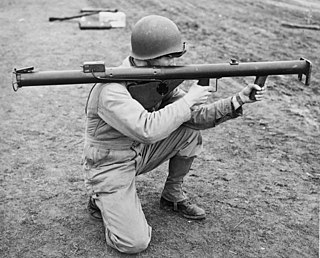 W
WA rocket launcher is a type of firearm that launches an unguided, rocket-propelled projectile, although the term is often used in reference to mechanisms that are portable and capable of firing actual rockets.
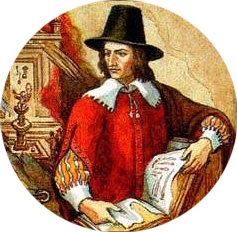 W
WKazimierz Siemienowicz was a general of artillery, gunsmith, military engineer, and one of pioneers of rocketry. Born in the Raseiniai region of the Grand Duchy of Lithuania, he served in the armies of the Polish–Lithuanian Commonwealth and of Frederick Henry, Prince of Orange, the ruler of the Netherlands. No portrait or detailed biography of him has survived and much of his life is a subject of dispute.
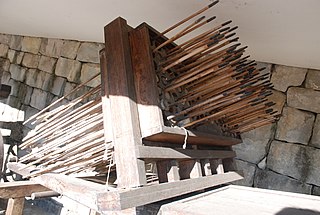 W
WSingijeon or shinkichon was a type of Korean fire arrow rocket, used during the era of the Joseon Dynasty (1392–1897). Multiple singijeon could be launched by hwacha.
 W
WThe Oerlikon-Bührle SNORA and SURA-D are 81-mm and 80-mm rockets developed in Switzerland in the late 1970s and fielded in the 1980s. The SNORA could be used in both air-to-surface and surface-to-surface rocket artillery roles, while the SURA-D is an air-to-surface rocket. The SNORA was developed as a cooperative endeavor with the Italian firm SNIA-Viscosa.
 W
WThe Thunderbolt-2000 is a wheeled MLRS system used by the Republic of China (Taiwan) Army. It was created with the intention of attacking enemy forces when disembarking from sea.
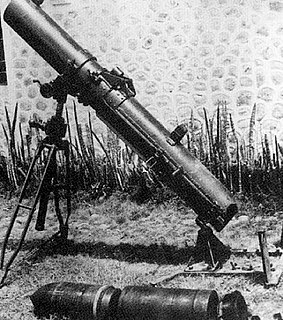 W
WThe Type 4 20 cm rocket mortar was a 203 mm rocket mortar used by the Imperial Japanese Army in the final stages of World War II.
 W
WThe Type 4 40 cm rocket mortar was a 400 mm (16 in) rocket used by the Imperial Japanese Army in the final stages of World War II.
 W
WThe Type 10 and Type 3 rocket boosters were rocket artillery systems used by garrison troops of the Imperial Japanese Navy during the late stages of World War II in defense of island bases in the Pacific.
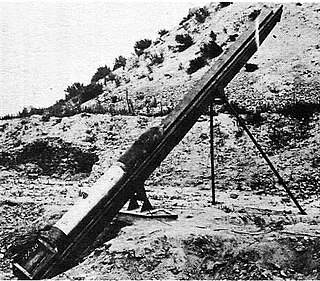 W
WThe Type 21 and Type 22 rocket-bombs were rocket artillery systems used by garrison troops of the Imperial Japanese Navy during the late stages of World War II in defense of island bases in the Pacific.
 W
WThe Type 63 multiple rocket launcher is a towed, 12-tube, 107mm rocket launcher produced by the People's Republic of China in the early 1960s and later exported and manufactured globally. Although no longer serving with active infantry units, the Type 63 is still in People's Liberation Army service with specialized formations such as mountain infantry units and special forces detachments. The Type 63 was widely used in the PLA until the late 1980s. It was adopted as the successor of the Type 50-5 of 102mm.
 W
WThis is a list of U.S. Army rocket launchers by model number. Launchers can be either tube-type or rail-type.
 W
WThe Valkiri is a South African self-propelled multiple rocket launcher. It is a 127mm system with a wheeled launcher vehicle, disposable pods, and fire control equipment developed by Denel Land Systems. Contemporary models consist of a single launch module with five eight-cell rocket pods on a Unimog or SAMIL-100 carrier. Its mission is to engage in counter-battery strikes against hostile artillery and air defences as far as 36 km (22 mi) away. Other potential warheads include cluster and an anti-tank mine dispenser.